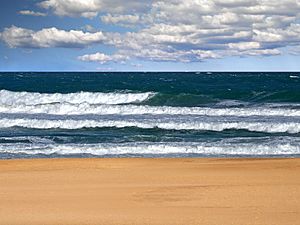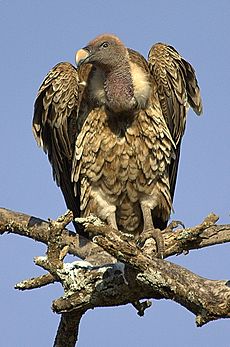Biosphere facts for kids
The biosphere is the part of Earth where all life exists. Think of it as a huge, thin layer around our planet that includes all living things and their surroundings. It's also called the ecosphere. This amazing system includes everything from tiny microorganisms to giant trees and animals.
The biosphere is like a nearly closed system for matter. This means that most of the materials, like water and nutrients, stay within the Earth's system. However, it's an open system for energy. This is because photosynthesis constantly captures solar energy from the sun. Scientists believe the biosphere started about 3.5 billion years ago, when life first appeared on Earth.
Sometimes, "biosphere" can also mean any closed ecological system that can regulate itself and contains ecosystems. This includes special artificial places like Biosphere 2 and BIOS-3. It could even include places on other planets or moons if life exists there!
Contents
What is the Biosphere?
The word "biosphere" was first used in 1875 by a geologist named Eduard Suess. He described it as the place on Earth's surface where life lives.
Later, in the 1920s, Vladimir Vernadsky helped us understand the biosphere in an ecological way. He saw it as a huge system that connects all living things with the non-living parts of Earth. This includes the lithosphere (the ground), the cryosphere (ice and snow), the hydrosphere (water), and the atmosphere (air).
Different Ways to Define It
Some scientists, like geochemists, define the biosphere more narrowly. For them, it's just the total sum of all living organisms, also known as biomass or biota. In this view, the biosphere is one of four main parts of Earth's system. The other three are the geosphere (rocks and land), the hydrosphere (water), and the atmosphere (air). When all four of these parts are combined, they form the ecosphere.
Scientists also study "biospherics." This is the science and technology of creating and studying artificial biospheres, like the ones built to learn about Earth's own biosphere.
Earth's Amazing Biosphere
How Old is Life on Earth?
Scientists have found very old signs of life on Earth. Some of the earliest evidence includes biogenic graphite from rocks in Greenland that are 3.7 billion years old. There are also microbial mat fossils from Australia that are 3.48 billion years old.
Even more recently, in 2017, scientists found possible microorganism fossils in Canada that could be 4.28 billion years old! This suggests that life appeared very quickly after Earth's oceans formed about 4.4 billion years ago. This is not long after Earth itself formed about 4.54 billion years ago. If life started so fast on Earth, it might mean life is common in the universe.
Where Can Life Be Found?
Life exists in almost every part of our planet. You can find it from the freezing polar ice caps to the warm equator. Even deep beneath the Earth's surface, there are many microbes. In fact, the total weight of microbial life underground might be more than all the animals and plants on the surface!
The biosphere is very thick. Birds can fly as high as 1,800 meters (about 5,900 feet). Fish live deep underwater, sometimes more than 8,300 meters (about 27,000 feet) down in places like the Puerto Rico Trench.
Some creatures live in even more extreme places:
- A Rüppell's vulture was seen flying at an amazing 11,300 meters (about 37,000 feet)!
- Bar-headed geese fly over the Himalayas at least 8,300 meters (about 27,000 feet) high.
- Yaks live in mountains as high as 5,400 meters (about 17,700 feet) above sea level.
- Mountain goats can live up to 3,050 meters (about 10,000 feet) high.
Life forms are found in soil, hot springs, and even inside rocks deep underground. Some microbes have been found 12 kilometers (about 7.5 miles) deep! They also exist high in the atmosphere, up to 40 kilometers (about 25 miles) high. The deepest parts of the world ocean also have many forms of marine life.
Microorganisms can even survive the vacuum of outer space under certain conditions. Scientists have found microbes living more than 10,000 meters (about 32,800 feet) deep in the Mariana Trench, the deepest spot in Earth's oceans. They have also found microbes thriving inside rocks under the sea floor. In Sweden, microbes were found more than 5,000 meters (about 3 miles) deep in the Earth's crust. The deepest life is often limited by temperature, as it gets hotter the deeper you go.
Earth's biosphere is divided into different biomes. These are areas with similar plants and animals. On land, biomes are mainly separated by how far they are from the equator. Areas near the Arctic Circle and Antarctic Circle have less plant and animal life. Most of the life is found closer to the equator.
How Life Changes Through the Year
Artificial Biospheres
Scientists have built special "artificial biospheres" to study ecosystems. They also want to see if humans could live in such systems outside of Earth. Some famous examples include:
- Biosphere 2 in Arizona, United States. It covers about 13,000 square meters (3.15 acres).
- BIOS-1, BIOS-2, and BIOS-3 in Siberia, Russia.
- Biosphere J (CEEF) in Japan.
- The Micro-Ecological Life Support System Alternative (MELiSSA) in Spain.
Life Beyond Earth?
So far, scientists have not found any biospheres beyond Earth. So, the idea of life on other planets is still a hypothesis. Some scientists think that complex life might be very rare in the universe. However, there are many planets that are similar to Earth, especially in our own Milky Way galaxy. For example, three planets orbiting the star TRAPPIST-1 might have biospheres.
Based on observations from the Kepler Space Telescope, some scientists believe that if life can start easily, the closest alien biosphere might be within 100 light-years of Earth.
It's also possible that humans might create artificial biospheres on other planets in the future. One idea is the terraforming of Mars, which would involve changing Mars to make it more like Earth and able to support life.
See also
 In Spanish: Biósfera para niños
In Spanish: Biósfera para niños
- Climate system
- Cryosphere
- Homeostasis
- Life-support system
- Man and the Biosphere Programme
- Montreal Biosphere
- Noosphere
- Rare biosphere
- Shadow biosphere
- Soil biomantle
- Wardian case
- Winogradsky column








